A Day at the Smithsonian
by Kevin Lawless and Doug MacGillvary
Reprinted from "Crown Jewels of the Wire", February 1999, page 6
Last summer we had the good fortune to spend a day at the Museum of American
History at the Smithsonian Institution in Washington, DC. Kevin had made an
appointment prior to our leaving for the Williamsburg, Virginia National, with
Nance Briscoe, the Specialist in charge of the Museum's technology exhibits,
including the insulators. That meeting was set for the morning of Monday, August
3.
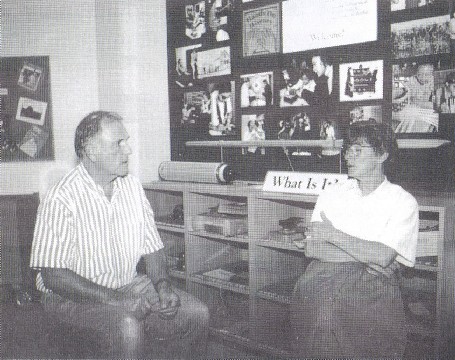
Doug MacGillvary and Nance Briscoe, Smithsonian Institution Specialist
Neither of us had a clear idea of what we would get to see and who we would
meet. but Nance was a most gracious hostess and, after a brief meeting to get
acquainted with one another and discuss our various goals for the day, along
with some concerns with some aspects of our hobby and with the collection
itself, Nance took us on a private tour of the entire collection of insulators.
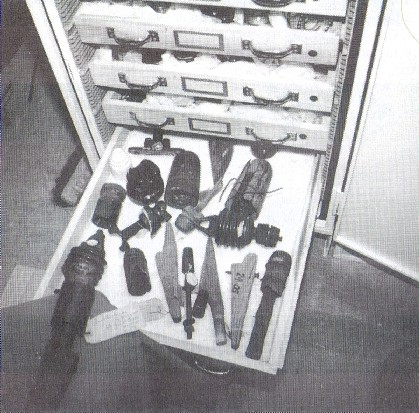
Stacked drawer cabinets which house the insulator collection.
The collection is housed in a locked and caged storage room. The majority of the insulators in the collection, of course, are pretty common.
There are also quite a few, however, that knocked our socks off. Among the
outstanding pieces in the collection are:
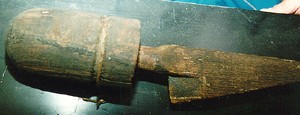
Several wood-covered Wades, one (above) donated
in 1904 has its
original pin.
A CD 731 Tillotson in dark sapphire-cobalt blue (not pictured) was donated to
the Western Union Museum in 1942 by W. Ralston, New York City Engineering
Department and several early Pond's insulators show in the open drawer (below).
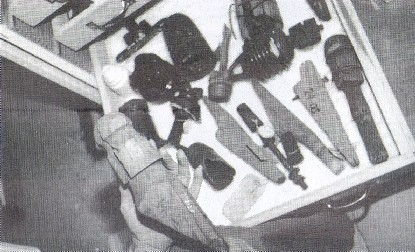
Nance holds an unusual wooden insulator on a side pin.
An early donation in 1898 brought a CD158 Boston (not pictured), a glass block,
a no hook "Kenosha", a Lefferts hook and several Ponds insulators.
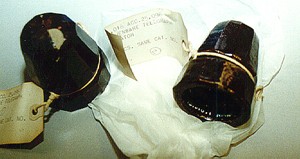
The only two known examples of what is presently identified as
U-978
were
loaned to the museum by William Kline of Toledo, Ohio and
donated through George
C. Maynard in 1904. This insulator was
thought to be threadless, but they are
THREADED, and at some
point in time the U-number assignment will need
correcting.

large glass block in ice aqua
and two Yandell's patents.
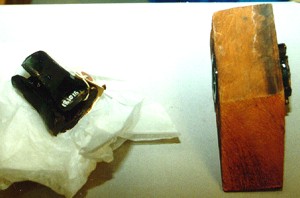
One on the left is completely exposed, while
the other is still embedded in a
piece of wood.
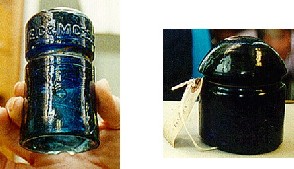
CD 140.6 "blob" in cobalt blue - in factory mint condition
was
donated in 1904 by A.E. Roome.
Also pictured, one of four cobalt blue EC&M's
in the museum.
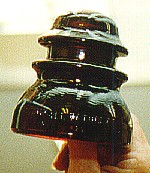
CD 154 Whitall Tatum No.1 in red amber
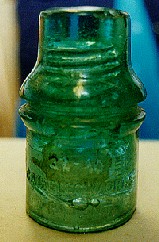
A CD 130.1 Cal. Elec. Works in aqua |
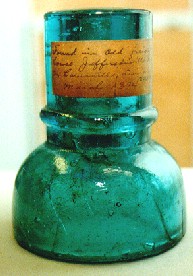
CD 737 No Name in aqua |
a MINT House insulator.
|
The insulator :vas used on lines that provided current for the telegraph
printing instrument designed by Royal House...a direct competitor of the system
developed by Samuel F. B. Morse. |
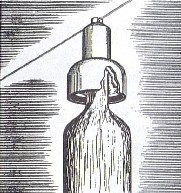 |
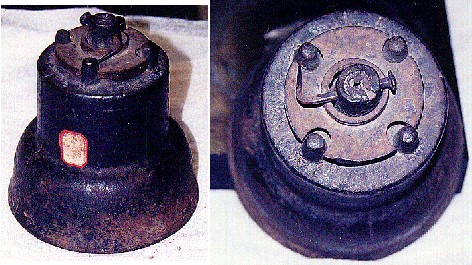 |
(David Sztramski, who visited the archives March, 1997, sent photos for use
whenever appropriate.. this was it! Thanks, Dave.)
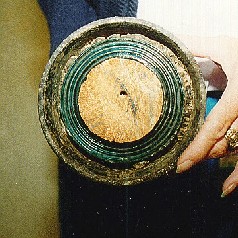
Nance Briscoe shows the original pole, ribbed
glass liner still intact within
the metal housing.
We photographed several of the most interesting pieces and left the rest of
the day for researching in the museum's archives of telegraphy documents, as
well as some of the histories of the insulators in the collection. We learned
that most of the rare pieces in the museum were donated between the years 1894
and 1913, as each piece is inventoried with a museum inventory number and
documentation as to who donated the piece, when and, wherever possible, location
where the insulator was used are included.
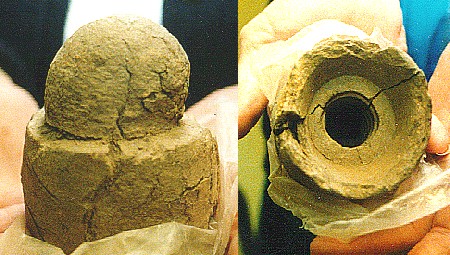
A 1915 donation -- an unusual threaded unfired porcelain signal...
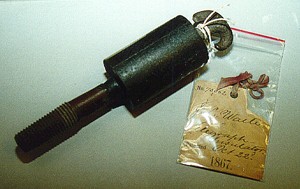
The J.C. Waite ramshorn style telegraph insulator patented October 22, 1867.
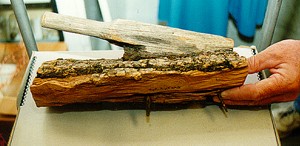
A threadless sidepin....
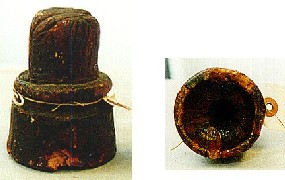
And, a very unusual threadless hat insulator made
of petrified wood donated
by J. C. Vail in 1913.
On the second floor of the museum is an exhibit called "Hands On
History", where many technological marvels of the past are exhibited, some
with "hands-on" educational interfaces. In that room, with bicycles
and telegraphs, are a makeshift pole with eight insulators displayed. This
exhibit is staffed by volunteers and is geared toward the younger audience. It
was not open to the public when we were given the opportunity to view it and, as
I recall, is only open 9 hours per week due to lack of funds and staff.
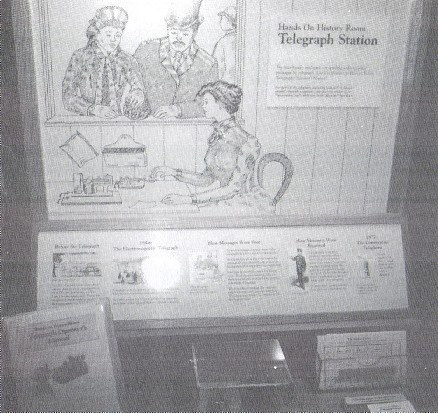
The Telegraph Station....
Nance's job duties required her time, but we spent the rest of our day in the
library reading original copies of The Telegrapher and other 19th Century
publications.
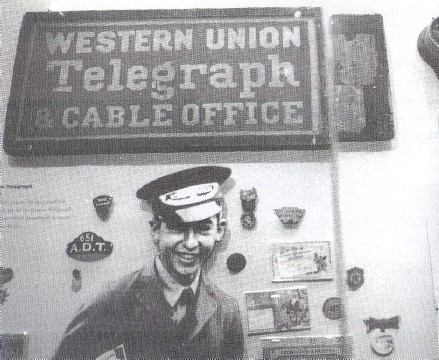
Part of the telegraph display....
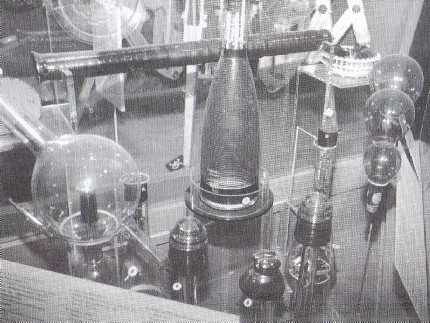
Other items donated for display, including three carnival
insulators...
two CD
142 Hemingray pieces and a CD 234 Pyrex.
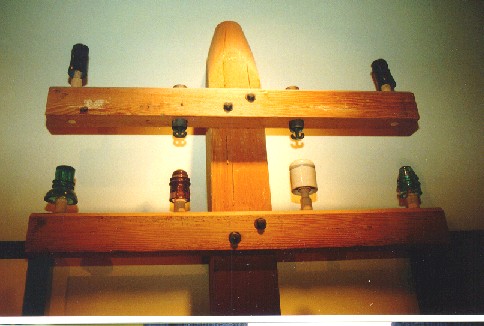
Display pole with eight insulators... Two cobalt EC&Ms, two Brookes
ramshorns, a CD 131 Brookfield, a WGM toll, an unembossed CD 737,
and an English
white porcelain piece.
We were elated to have the opportunity to spend a day at the Museum of
American History. We learned about the museum's collection, where it originated
from, the problems with keeping a massive undertaking as the museum afloat with
very limited funding and manpower, and the dedication of staff like Nance Briscoe. Our next trip to our Nation's capital will assuredly bring us back to
the Museum of American History!
| 